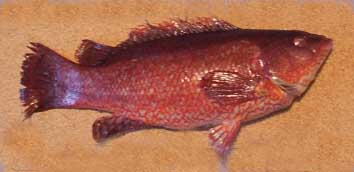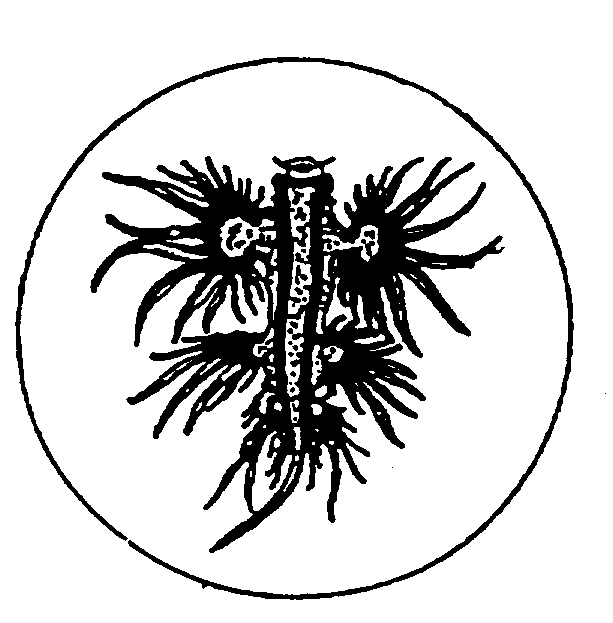| Identification:
Similar species in the Mediterranean is Labrus viridis
(Fishbase
entry)
Other British Wrasse
(link)
Breeding:

 Juvenile
Fish Juvenile
Fish
Photograph
by Brian May
Habitat:
Ballan Wrasse can be kept in aquaria for
several years from first year fish. Eventually, they grow too large (in
3 years they can reach a length of 21 cm and a weight of 230 g = 8 oz)
even for home aquaria. The do not require the aquaria to be cooled and
will survive in temperatures up to 26° C for short periods during the
summer.
Another fish grew to 11 cm by the third year.
Food:
Range:
Parasites/Commensals:
I remember seeing a large fishlouse (about 3
cm) attached to an adult Ballan Wrasse while snorkelling off Guernsey
a few years back. (written in 2001).
Adam
Cooper
Additional Notes:
Information wanted: Please send any records of this fish, with
location, date, who discovered it, how it was identified, prevalence, common
name and any other details to
Shorewatch Project  EMail Glaucus@hotmail.com.
EMail Glaucus@hotmail.com.
All messages will receive a reply.
Reports:
Hello,
After searching through the internet for information
regarding Ballan Wrasse fish, I ended at your site. I was after details
& description of this said fish.
The reason why, is that after recently returning
from my holidays in Cornwall, I was interested to know more about the fish
which my wife had unusually caught
last Saturday 4th August 2000 at Fowey harbour
wall. We had gone down to Fowey in the early evening with our two young
children, to have a meal, and then to do some
crabbing with the children. Armed with a couple
of 99 pence crab lines & some
mackerel bait, in went the lines. However,
10 mins later no crabs appear on the
hooks, but a very large reddish coloured fish,
on my wife's line, to which later
we where told its a wrasse! Its size was
approximately 18 inches nose to tail
may be longer, & 6-7 inches body depth not
inclusive of its dorsal fin. After
panicking how & what to do, my wife started
to bring the fish into the harbour
steps whilst reeling in her crab line. I was
promptly told to go off & find a fisherman who would know what to do
with respect of getting this monster fish off her line. On my return from
an unsuccessful pilgrimage into the local working men's club at the jetty?
a large entourage of spectators had gathered in bemusment at the spectacle.
Fortunately a gentleman amongst the crowd who seemed comfortable about
removing the hook, readily stepped in to help land the fish, remove the
hook & returned the fish back to the water. Unfortunately what we didn't
get a chance to do was take a photo whilst the fish was out of water &
accurately gage the weight of this fish. From the approximate dimensions,
to
which I've deliberately underestimated the dimensions,
to what approximate weight do you think this fish could have been, &
is it unusual to catch this fish in this manner. Needless to say, after
the fish was returned, we all decided that the catch of this fish more
than compensated for the lack of crabs and so we packed up for the night.
Both our children agreed that their mum was the best fisher woman in Cornwall.
I did manage to take a photo of the fish, but
I suspect when I get it developed it will show no scale as I took it as
she was reeling it in.
Regards
Richard
Williams
Sender: Richard.Williams3@ilford.com
18 September 2001
This wrasse has been recorded off the Shetland
Isles (Report by Ronnie
MacLean from Yell).

It was red, 33 cm length, 800 g (1 lb 12
oz),
caught off the Woodwick shore off Unst, Shetland in a lobster creel.
The skipper had not seen one before. It was originally identified
by the librarian. Our headteacher said he sometimes caught them,
and someone else said one had turned up in an eel fishing competition.
They appear to be present but caught rarely. It is sitting in my
fridge to be photoed after school and then eaten by the
librarian.
Best wishes
Ronnie
MacLean
Ballan Wrasse are extremely common here in Loch
Roag Isle of Lewis and elsewhere around the island, often growing to a
considerable size. They seem to live in family groups, show a wide variety
of colouration, and are often found around rocky reefs with moderate exposure.
The strange thing is few locals ever seem to catch any, and those that
do claim never to have seen them before despite a lifetime's fishing. I
found this surprising, but
suppose that they must be difficult to catch
using normal bait. Other wrasse are common too, especially in late summer,
Goldsinny
Wrasse in particular.
My local paper today reports that local fish
farms are to increase the capture and use of goldsinny wrasse as cleaner
fish to control lice in salmon farms, in an allegedly sustainable way (what
else?) I've always thought of them as being territorial fish - does anybody
know if this is the case and what effect removal from an area might have?
Paul Tyler
1 April 2004
The
first fish to arrive on the sunken wreck of the Scylla
was a Ballan Wrasse
Wrasse Page
|


